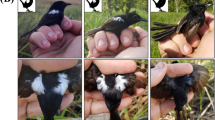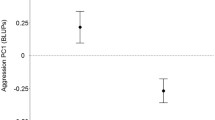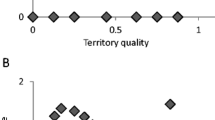Abstract
The evolution and function of female trait exaggeration in species with traditional sex roles are poorly understood. Competition for social and ecological resources, rather than mating opportunities, may be a key selection pressure in females of socially monogamous species. Moreover, such pre-existing resource competition-selected traits (armaments) may become the object of mating preferences (ornaments); however, the benefits that males may gain in choosing more ornamented females remain unclear. Here, using observational data on free-living female great tits (Parus major), we explore whether tie size, a well-known melanin-pigmented plumage trait, covaries with intrasexual aggressiveness during the breeding season and the investment in current reproduction (fledgling number and mass). We found consistent individual differences (i.e. personality variation) in most of the aggressiveness parameters studied. Moreover, we found support for a signalling role of tie size with respects to how close females approached intruders. Interestingly, this relationship was only evident in older females, not first-year breeding females, suggesting age-related changes in the information content of tie size in the context of same-sex aggressiveness. Additionally, although first-year breeding females, on average, produced fledglings with lower body mass compared to older females, tie size was positively associated with fledgling mass, suggesting that males could potentially gain benefits by choosing females with larger tie size. Experimental studies are now necessary to confirm whether females with larger tie size have a selective advantage in female competition (i.e. armament), as well as whether males base their mate choice on female tie size (i.e. ornament).
Significance statement
Why females of many species with traditional sex roles often have exaggerated traits very similar to those found in males remains poorly understood. We explored the functional significance of a well-known melanin-based plumage trait (tie size) in females of a socially monogamous passerine bird, the great tit. Female tie size positively covaried with consistent individual differences in aggressiveness during female-female interactions, but only so in older females and not first-year breeding females. In addition, females with larger tie size produced fledglings with higher body mass, suggesting that it could potentially be used by males in mate choice. Our study emphasizes that greater attention should be paid to female trait exaggeration in socially monogamous species in the context of female-female competition and male mate choice, as well as to potential age-related changes in the information they convey.


Similar content being viewed by others
References
Amundsen T (2000) Why are female birds ornamented? Trends Ecol Evol 15:149–155
Amundsen T, Pärn H (2006) Female coloration: review of functional and nonfunctional hypotheses. In: Hill GE, McGraw KJ (eds) Bird coloration, Function and evolution, vol 2. Harvard University Press, Cambridge, pp 280–345
Andersson M (1994) Sexual selection. Princeton University Press, Princeton
Araya-Ajoy YG, Dingemanse NJ (2014) Characterizing behavioural ‘characters’: an evolutionary framework. Proc R Soc B 281:20132645
Araya-Ajoy YG, Dingemanse NJ (2016) Repeatability, heritability, and age-dependence in the aggressiveness reaction norms of a wild passerine bird. J Anim Ecol 86:227–238
Berglund A, Bisazza A, Pilastro A (1996) Armaments and ornaments: an evolutionary explanation of traits of dual utility. Biol J Linn Soc 58:385–399
Blows MW (2007) A tale of two matrices: multivariate approaches in evolutionary biology. J Evol Biol 20:1–8
Both C, Visser ME, Verboven N (1999) Density-dependent recruitment rates in great tits: the importance of being heavier. Proc R Soc Lond B 266:465–469
Bouwhuis S, Sheldon BC, Verhulst S, Charmantier A (2009) Great tits growing old: selective disappearance and the partitioning of senescence to stages within the breeding cycle. Proc R Soc Lond B 276:2769–2777
Clutton-Brock T (2007) Sexual selection in males and females. Science 318:1882–1885
Clutton-Brock T (2009) Sexual selection in females. Anim Behav 77:3–11
Costanzo A, Romano A, Ambrosini R, Parolini M, Rubolini D, Caprioli M, Corti M, Canova L, Saino N (2018) Barn swallow antipredator behavior covaries with melanic coloration and predicts survival. Behav Ecol 29:1472–1480
Da Silva A, van den Brink V, Emaresi G, Luzio E, Bize P, Dreiss AN, Roulin A (2013) Melanin-based colour polymorphism signals aggressive personality in nest and territory defence in the tawny owl (Strix aluco). Behav Ecol Sociobiol 67:1041–1052
Dhondt AA (1989) The effect of old age on the reproduction of great tits Parus major and blue tits P. caeruleus. Ibis 131:268–280
Dhondt AA, Schillemans J (1983) Reproductive success of the great tit in relation to its territorial status. Anim Behav 31:902–912
Dingemanse NJ, Dochtermann NA (2013) Quantifying individual variation in behaviour: mixed-effect modelling approaches. J Anim Ecol 82:39–54
Ducrest AL, Keller L, Roulin A (2008) Pleiotropy in the melanocortin system, coloration and behavioural syndromes. Trends Ecol Evol 23:502–510
Garamszegi LZ, Rosivall B, Hegyi G, Szöllösi E, Török J, Eens M (2006) Determinants of male territorial behavior in a Hungarian collared flycatcher population: plumage traits of residents and challengers. Behav Ecol Sociobiol 60:663–671
Gelman A, Su YS, Yajima M, Hill J, Pittau MG, Kerman J, Zheng T, Dorie V (2015) Arm: data analysis using regression and multilevel/hierarchical models. R package version 1:10–11 https://CRAN.R-project.org/package=arm
Griggio M, Zanollo V, Hoi H (2010) Female ornamentation, parental quality, and competitive ability in the rock sparrow. J Ethol 28:455–462
Harvey PH, Greenwood PJ, Perrins CM (1979) Breeding area fidelity of great tits (Parus major). J Anim Ecol 48:305–313
Hegyi G, Szigeti B, Török J, Eens M (2007) Melanin, carotenoid and structural plumage ornaments: information content and role in great tits Parus major. J Avian Biol 38:698–708
Hegyi G, Garamszegi LZ, Eens M, Török J (2008) Female ornamentation and territorial conflicts in collared flycatchers (Ficedula albicollis). Naturwissenschaften 95:993–996
Hoi H, Griggio M (2008) Dual utility of a melanin-based ornament in bearded tits. Ethology 114:1094–1100
Immonen E, Hämäläinen A, Schuett W, Tarka M (2018) Evolution of sex-specific pace-of-life syndromes: genetic architecture and physiological mechanisms. Behav Ecol Sociobiol 72:60
Jakobsson S (1988) Territorial fidelity of willow warbler (Phylloscopus trochilus) males and success in competition over territories. Behav Ecol Sociobiol 22:79–84
Järvi T, Bakken M (1984) The function of the variation in the breast stripe of the great tit (Parus major). Anim Behav 32:590–596
Johnstone RA, Norris K (1993) Badges of status and the cost of aggression. Behav Ecol Sociobiol 32:127–134
Kluijver HN (1951) The population ecology of the great tit (Parus m. major L.). Ardea 39:1–135
Kokko H (1997) Evolutionarily stable strategies of age-dependent sexual advertisement. Behav Ecol Sociobiol 41:99–107
Kölliker M, Heeb P, Werner I, Mateman AC, Lessells CM, Richner H (1999) Offspring sex ratio is related to male body size in the great tit (Parus major). Behav Ecol 10:68–72
Kraaijeveld K, Gregurke J, Hall C, Komdeur J, Mulder RA (2004) Mutual ornamentation, sexual selection, and social dominance in the black swan. Behav Ecol 15:380–389
Kraaijeveld K, Kraaijeveld-Smit FJL, Komdeur J (2007) The evolution of mutual ornamentation. Anim Behav 74:657–677
Krebs JR (1982) Territorial defence in the great tit (Parus major): do residents always win? Behav Ecol Sociobiol 11:185–194
Lande R (1980) Sexual dimorphism, sexual selection, and adaptation in polygenic characters. Evolution 34:292–305
López-Idiáquez D, Vergara P, Fargallo JA, Martínez-Padilla J (2016) Female plumage coloration signals status to conspecifics. Anim Behav 121:101–106
Maynard Smith JM, Harper DGC (1988) The evolution of aggression: can selection generate variability? Phil Trans R Soc B 319:557–570
Maynard Smith J, Parker GA (1976) The logic of asymmetric contests. Anim Behav 24:159–175
Morales J, Gordo O, Lobato E, Ippi S, Martínez-de la Puenta J, Tomás G, Merino S, Moreno J (2014) Female-female competition is influenced by forehead patch expression in pied flycatcher females. Behav Ecol Sociobiol 68:1195–1204
Naef-Daenzer B, Widmer F, Nuber M (2001) Differential post-fledging survival of great and coal tits in relation to their condition and fledging date. J Anim Ecol 70:730–738
Nakagawa S, Schielzeth H (2010) Repeatability for Gaussian and non-Gaussian data: a practical guide for biologists. Biol Rev 85:935–956
Nicolaus M, Piault R, Ubels R, Tinbergen JM, Dingemanse NJ (2016) The correlation between coloration and exploration behaviour varies across hierarchical levels in a wild passerine bird. J Evol Biol 29:1780–1792
Norris K (1990) Female choice and the evolution of the conspicuous plumage coloration of monogamous male great tits. Behav Ecol Sociobiol 26:129–138
Norris K (1993) Heritable variation in a plumage indicator of viability in male great tits Parus major. Nature 362:537–539
Perrins CM, McCleery RH (1985) The effect of age and pair bond on the breeding success of great tits Parus major. Ibis 127:306–315
Perrins CM, McCleery RH (2001) The effect of fledging mass on the lives of great tits Parus major. Ardea 89:135–142
Poysa H (1988) Feeding consequences of the dominance status in great tit Parus major groups. Ornis Fenn 65:69–75
Quesada J, Senar JC (2007) The role of melanin- and carotenoid-based plumage coloration in nest defence in the great tit. Ethology 113:640–647
R Core Team (2019) R: a language and environment for statistical computing. R Foundation for Statistical Computing, Vienna http://www.R-project.org
Raap T, Pinxten R, Eens M (2015) Light pollution disrupts sleep in free-living animals. Sci Rep 5:13557
Remeš V, Matysioková B (2013) More ornamented females produce higher-quality offspring in a socially monogamous bird: an experimental study in the great tit (Parus major). Front Zool 10:14
Riddington R, Gosler AG (1995) Differences in reproductive success and parental qualities between habitats in the great tit Parus major. Ibis 137:371–378
Rivera-Gutierrez HF, Pinxten R, Eens M (2010) Multiple signals for multiple messages: great tit, Parus major, song signals age and survival. Anim Behav 80:451–459
Roulin A (2004) Proximate basis of the covariation between a melanin-based female ornament and offspring quality. Oecologia 140:668–675
Roulin A (2016) Condition-dependence, pleiotropy and the handicap principle of sexual selection in melanin-based colouration. Biol Rev 91:328–348
Santostefano F, Fanson KV, Endler JA, Biro PA (2019) Behavioral, energetic, and color trait integration in male guppies: testing the melanocortin hypothesis. Behav Ecol 30:1539–1547
Senar JC, Conroy MJ, Quesada J, Mateos-Gonzalez F (2014) Selection based on the size of the black tie of the great tit may be reversed in urban habitats. Ecol Evol 4:2625–2632
Slagsvold T (1993) Female-female aggression and monogamy in great tits Parus major. Ornis Scand 24:155–158
Stern CA, Servedio MR (2017) Evolution of a mating preference for a dual-utility trait used in intrasexual competition in genetically monogamous populations. Ecol Evol 7:8008–8016
Svensson L (1992) Identification guide to European passerines, 4th edn. BTO, Stockholm
Tarof SA, Dunn PO, Whittingham LA (2005) Dual functions of a melanin-based ornament in the common yellowthroat. Proc R Soc Lond B 272:1121–1127
Thys B, Pinxten R, Raap T, De Meester G, Rivera-Gutierrez HF, Eens M (2017) The female perspective of personality in a wild songbird: repeatable aggressiveness relates to exploration behaviour. Sci Rep 7:7656
Thys B, Lambreghts Y, Pinxten R, Eens M (2019) Nest defence behavioural reaction norms: testing life-history and parental investment theory predictions. R Soc Open Sci 6:182180
Tobias JA, Montgomerie R, Lyon BE (2012) The evolution of female ornaments and weaponry: social selection, sexual selection and ecological competition. Phil Trans R Soc B 367:2274–2293
Van Duyse E, Pinxten R, Eens M (2000) Does testosterone affect the trade-off between investment in sexual/territorial behaviour and parental care in male great tits? Behaviour 137:1503–1515
West-Eberhard MJ (1983) Sexual selection, social competition, and speciation. Q Rev Biol 55:155–183
Wong BBM, Candolin U (2005) How is female mate choice affected by male competition? Biol Rev 80:559–571
Acknowledgements
We like to thank Geert Eens, Wannes Leirs, Thomas Raap, Peter Scheys, Bo Sterckx and Emma Van den Camp for invaluable support during fieldwork. Special thanks to Melissa Grunst and Andrea Grunst for help with collecting photographs of birds and useful discussion. The editor and two anonymous reviewers providing valuable feedback on an earlier version of the manuscript.
Funding
This study was made possible through financial support from the University of Antwerp (to BT, RP and ME) and the ‘Fonds Wetenschappelijk Onderzoek’ (FWO) Flanders through a PhD fellowship to BT (grant ID: 1.1.434.18N) and a FWO-project to RP and ME (project ID: G0A36.15).
Author information
Authors and Affiliations
Contributions
All authors contributed to conceiving and designing the study. BT performed the fieldwork, statistical analyses and wrote the first draft of the manuscript. All authors contributed to revising the manuscript and gave final approval for publication.
Corresponding author
Ethics declarations
Conflict of interest
The authors declare that they have no conflict of interest.
Ethical approval
Experiments were approved by the ethical committee of the University of Antwerp (ID 2014-88 and ID 2017-23) and performed in accordance with Belgian and Flemish laws. The Royal Belgian Institute of Natural Sciences provided ringing licences for all authors and technicians.
Additional information
Communicated by K. van Oers
Publisher’s note
Springer Nature remains neutral with regard to jurisdictional claims in published maps and institutional affiliations.
Electronic supplementary material
ESM 1
(DOCX 16 kb)
Rights and permissions
About this article
Cite this article
Thys, B., Pinxten, R. & Eens, M. Does the tie fit the female? Melanin-based colouration, aggressive personality and reproductive investment in female great tits (Parus major). Behav Ecol Sociobiol 74, 43 (2020). https://doi.org/10.1007/s00265-020-2828-z
Received:
Revised:
Accepted:
Published:
DOI: https://doi.org/10.1007/s00265-020-2828-z




